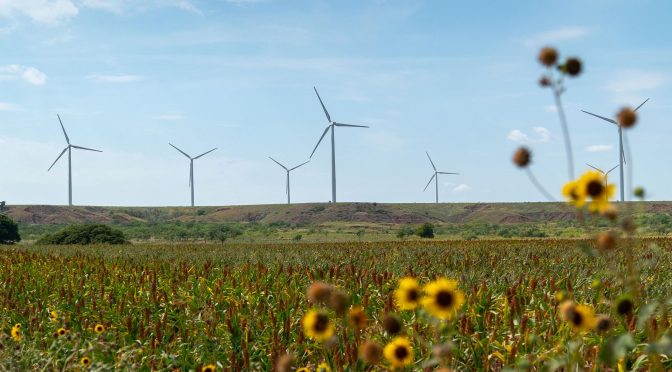Enel Green Power has launched an initiative to protect bird species that risk flying into wind turbines. We’re protecting local wildlife and biodiversity by making our wind farms even more in tune with nature.
June 15 is World Wind Day, an opportunity to raise awareness among people and institutions on the subject of renewable energy and wind power in particular. According to statistics published by the World Wind Energy Association (WWEA), the total power generation capacity of wind farms currently exceeds 840 GW. It should be noted that a installation that produces 10 MW saves 7,000 tons of oil and provides electricity to about 7,000 families. Considering that for 60% of the population wind power is the most affordable option for producing electricity, the importance of this sector for the energy transition and sustainable development is undeniable.
In this context, building wind farms that are efficient and respectful of the environment and winged wildlife is a fundamental challenge for the near future, and we at Enel Green Power have already tested systems capable of safeguarding the environment and biodiversity. In Gibson Bay, for example, specific ultrasonic sensors keep bats away from the rotating blades, while in Pezouliotika (in Greece) some species of trees have been planted to improve the food supply to protect the wildlife present in the area. And again, in Spain, thanks to a leguminous plant, the nesting and foraging of some bird species have been made easier, and it also improves the oxygenation of the soil.
Innovative solutions to protect birdlife
Birds are exceptional navigators, capable of following invisible routes, plotting detailed maps of regions, and avoiding dangerous places. However, their coexistence with us humans, with our infrastructures and our means of transport, is not always easy for birds and other winged creatures. Each year, numerous birds collide with buildings, bridges, power grids, etc., and even end up colliding with the rotating blades of turbines on wind farms. To minimize the impact on the bird population by preventing birds from colliding with the turbines, we’ve launched an experimental campaign to test innovative solutions. In addition to protecting birds, the data obtained from these tests will provide very important information for designing and positioning the energy infrastructures of the future, in order to minimize or completely cancel their environmental impact.
Energy sustainability goes hand in hand with environmental sustainability
Making energy facilities sustainable means not only eliminating harmful emissions and harnessing renewable resources, but also protecting biodiversity and natural habitats. We make our contribution through a number of innovative, high tech projects. The first initiative of this kind was carried out in the aforementioned Gibson Bay, in South Africa, where three ultrasonic devices were installed, capable of creating a barrier effect around the turbine with the aim of deterring bats from getting close to the wind turbines, thereby avoiding the occurrence of overpressure which is fatal for the cardiovascular system of bats.
In the wake of this initiative, we’ve also launched a test program in Spain and Italy: this is a way to make wind farms more sustainable by using cutting-edge tools and devising innovative management strategies. These systems are based on the use of radar technologies, video cameras and microphones, with the aim of creating deterrents that keep birds and other winged creatures away. The experimentation and design of these new tools is the result of partnerships with technology suppliers, universities and research centers which, by bringing together the varied knowledge in an Open Innovability® perspective, aim to create increasingly effective solutions. Ornithological specialists have also given their contribution, by defining the specific characteristics of the mitigation activities and providing information on the behavior of the various species. The real innovation comes from the continuous monitoring of data on all the projects implemented by Enel Green Power, with the aim of finding and testing increasingly cutting-edge solutions.
“The results of these tests will allow the development of a ‘business decision support system’ that will help define the best technological and habitat management strategy to improve the environmental and social sustainability of photovoltaic and wind power plants, in favor of biodiversity protection, without disrupting the surrounding landscape and perfectly in tune with nature.”
Miriam Di Blasi, Head of Environment and Impacts Mitigation Innovation
Large-scale future prospects
Thanks to the data produced in our wind farms, it will be possible to monitor the results and evaluate the real benefit of bird population protection systems, giving rise to increasingly effective solutions. This is a project that could have wide-ranging applications, even to the point of determining a reorganization of the renewable energy production systems themselves, including in the field of photovoltaics and hydroelectricity.
Detecting the behavior of wildlife present in areas close to wind farms allows us to understand the behavior of these populations during different times of the year, including with regard to their relationship with humans. In short, it’s a way to study the habits of a large number of species, stimulating the search for creative solutions adapted to each reference area. Detailed territorial analyses will also derive from this approach, to better define the ideal location of future wind farms by evaluating possible actions to safeguard biodiversity in addition to energy efficiency.
These innovations in wind farms allow us to make great strides towards a definitive exit from fossil fuel dependence, without causing impacts on the environment and biodiversity. In parallel, wind-based renewable energy sources are one of the key technologies for economic recovery and the creation of millions of jobs, moving us closer to a fully sustainable future.


